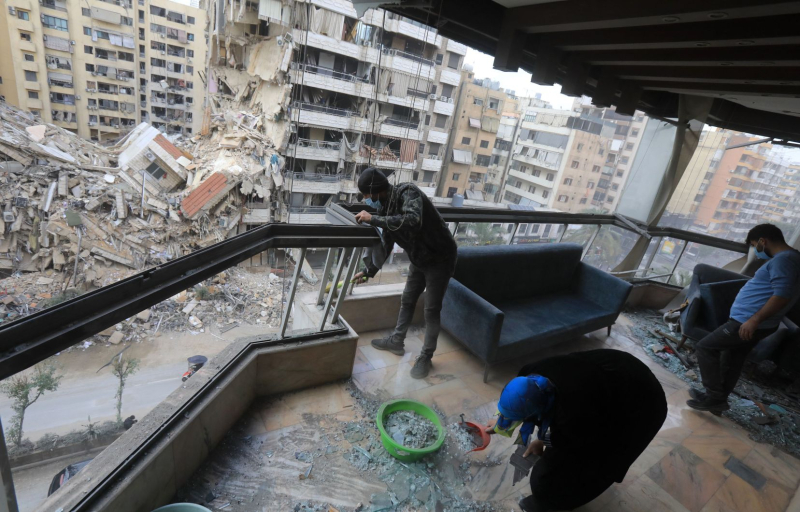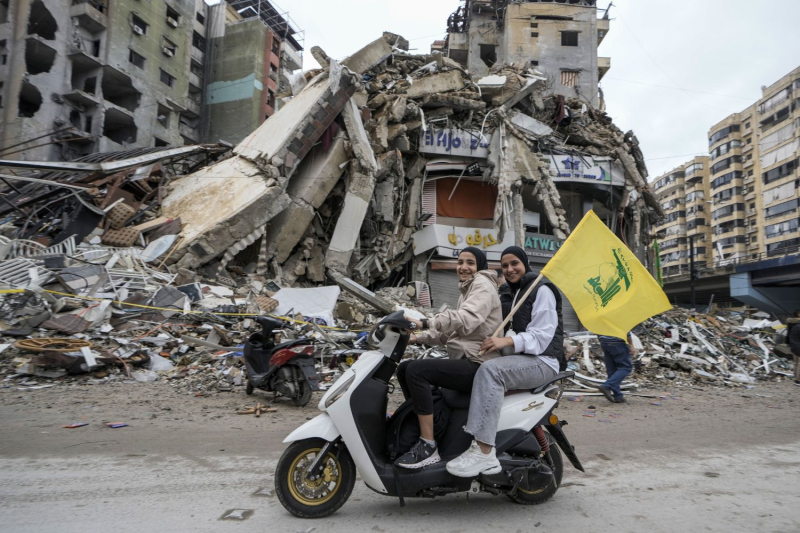
Photo: Agence France-Presse Lebanese people clean their apartment after returning home, Wednesday, in the southern suburbs of Beirut.
Aya Iskandarani – Agence France-Presse and Pierre-Henry Deshayes – Agence France-Presse in Beirut and Jerusalem
Posted yesterday at 16:07 Updated yesterday at 16:20
- Middle East
Tens of thousands of Lebanese displaced by the war between Hezbollah and Israel returned home Wednesday, to find their towns and villages devastated after the ceasefire came into effect.
The truce ends the conflict that began more than 13 months ago between the Israeli army and the Lebanese Islamist movement, which turned into open war in September and left thousands dead. Around 900,000 people have been displaced in Lebanon and 60,000 in northern Israel.
Before dawn, displaced residents of southern Lebanon, the southern suburbs of Beirut and the Bekaa in the east of the country, Hezbollah strongholds, set off in their thousands for home, in overloaded cars and minibuses, mattresses and suitcases piled on the roofs.
In the ruins of the southern suburbs, Hezbollah supporters waved its yellow flag or portraits of their leader, Hassan Nasrallah, killed in late September by Israel.
“This heroic suburb” has “victorious, we are proud,” Nizam Hamadeh, an engineer, told AFP.
The Shiite movement, decapitated by Israeli strikes, nevertheless proclaimed its “victory,” adding that its fighters “will remain fully prepared to face […] attacks by the Israeli enemy.”
Back in Nabatiyé, in southern Lebanon, Ali Mazraani said he was “shocked by the massive destruction” of this city, which now seems foreign to him.
“Despite the extent of the destruction and our grief, we are happy to be back,” said Oum Mohamed Bzeih, a 44-year-old widow who returned to her devastated home in the village of Zebqine. “We feel reborn.” »
Hezbollah, an ally of Iran, had opened a “support” front for Hamas against Israel at the start of the war in the Gaza Strip, triggered on October 7, 2023 by the unprecedented attack of the Palestinian Islamist movement.
After months of exchanges of fire on both sides of the Israeli-Lebanese border, Israel launched, on September 23, a campaign of massive bombings on the movement’s strongholds, followed by ground operations in southern Lebanon, claiming to want to secure its northern border and allow the return of displaced people.

Photo: Bilal Hussein Associated Press Two women ride a moped in Beirut’s Dahiyeh neighborhood, waving a Hezbollah flag.
Phasal withdrawal
Under the terms of the agreement sponsored by the United States and France, the Israeli army has 60 days to gradually withdraw from Lebanon. Hezbollah must also withdraw to the north of the Litani River, about thirty kilometers from the border, and dismantle its military infrastructure in southern Lebanon.
The Lebanese army announced on Wednesday that it was beginning, “in coordination” with the UN peacekeeping force, UNIFIL, to strengthen its presence in the south.
The Israeli army, for its part, called on residents not to approach its positions in southern Lebanon.
“We control positions in southern Lebanon, our planes continue to fly in the Lebanese sky. […] Today, we arrested suspects and killed terrorists,” declared army spokesman Rear Admiral Daniel Hagari. He added that the army had struck “180 targets” during the night before the ceasefire.
According to Lebanese authorities, at least 3,823 people have been killed in the country since October 2023, most since late September. On the Israeli side, 82 soldiers and 47 civilians have died in 13 months, according to the authorities.
According to US President Joe Biden, the agreement must prevent “what remains of Hezbollah” and other groups from “again threatening Israel’s security.”
Washington and Paris relied on UN Security Council Resolution 1701, which ended the previous war between Israel and Hezbollah in 2006 and which stipulates that only the Lebanese army and UNIFIL can be deployed in the border regions of southern Lebanon.
Israel reserves “complete freedom of military action” in Lebanon, “if Hezbollah violates the agreement and attempts to rearm,” its Prime Minister, Benjamin Netanyahu, warned.
The Shiite movement will cooperate with the Lebanese state to strengthen the deployment of the army in the south, one of its deputies, Hassan Fadlallah, assured AFP on Wednesday. But its members “are the children of the villages” in the south, from where “no one” can drive them out, he added.
Read also
- Israel, Hezbollah to halt fighting
- Why Israel has stepped up its strikes on Syria ?
“Not completely reassured”
After more than a year of rushing to shelters as soon as the sirens sounded, residents of northern Israel were enjoying the newfound calm on Wednesday, but remained on their guard.
In Nahariya, a coastal city within rocket range of Lebanese territory, Baha Arafat, 44, said he was relieved. “I feel much better now that I know there is a ceasefire,” he said. “There is no shelter around here and the last few days have been tense.”
“There is a sense of greater security, our children can go back to school,” said Yuri, 43, displaced from his Kibbutz Yiron, near the border in Haifa. But “we don’t feel completely reassured,” because “Hezbollah still has forces,” he added.
Netanyahu said the truce would allow Israel to “focus on the Iranian threat” and “intensify” its pressure on Hamas.
Israeli columnists were skeptical, fearing that Hezbollah would rebuild its forces or pointing to the lack of progress toward a truce in Gaza.
Israel intends to “make every effort to create the conditions for a new hostage exchange,” assured Israeli Defense Minister Israel Katz.
With two months to go before the end of his term, Joe Biden will renew his efforts to achieve a ceasefire in Gaza, by involving “Turkey, Qatar, Egypt and other actors in the region,” according to his national security adviser, Jake Sullivan.
A Hamas official told AFP on Wednesday that his movement was “ready for a ceasefire agreement” in Gaza.

